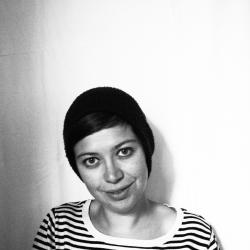Absolute darkness surrounds us. You can’t even see your hands—and you hear nothing but your own breathing. We stand there for a few moments before our guide, Adrien, fills the silence with a story of a man who got lost and died in the underground labyrinths of Paris. A few minutes later a light shines our way and a voice says, “You can turn your lights on again.” Suddenly we see the other part of our caving group.

Equipped with helmets, lights and pretty nice neon-yellow fisherman’s pants, the seven of us are exploring Leiðarendi, one of hundreds of lava tubes in Iceland. It is located in the 2,000-year-old lava fields of Stóribolli on the Reykjanes peninsula, a mere thirty minutes outside of Reykjavík. “We can enter this tube only because its ceiling collapsed,” explains Adrien, who came to Iceland from Paris to be a diving guide and recently started caving as well. “Only a few lava tubes are accessible like this one,” he tells us. “Most are hidden and inaccessible underground.”

By the seat of our trousers
Entering the cave was an adventure in itself: on the seats of our trousers, we had slid into an icy world of lava, stones covered with ice and sparkling icicles in all sizes. Farther back in the cave it became warmer, fewer and fewer icicles hung from the ceiling, the cave walls sparkled in colours between red grey and blue and we passed strange lava formations. One was supposed to look like Abraham Lincoln, but not even Adrien could point him out. Most of the lava formations did look like petrified trolls, though, their faces and extremities protruding from the surface. But of course fantasy is always near in the darkness below the ground.

While thinking about Iceland, volcanoes and caves, Jules Verne’s ‘Journey to the Centre of the Earth’ comes to mind, but exploring this 900-metre-long lava tube isn’t exactly like a journey to the middle of the planet. There are no petrified trees, no giant mushrooms and no prehistoric fighting. Besides us, the only beings in the cave were some micro-organisms, which concentrate on the cave’s ceiling, casting pretty formations that look like the “silver of the elves,” as Adrien put it. However, it looks like an intrepid sheep once found its way into the cave as well. “It probably fell into one of the holes of the cave and died of hunger, unable to find its way out again,” Adrien said, pointing to a pile of bones. This seems fitting given the cave’s name: Leiðarendi means “end of the road,” and here the road ended—for the sheep. “But the real question is: How did it manage do get this far into the cave” he asks “and why did it go this far?” A sheep’s brain is murky.

Crawling back to the surface
We continued in a circular route, sometimes forced to crawl on the ground, as the cave narrowed. “Thank god I have a helmet!” I heard someone say, bumping their head on the low cave ceiling. This irregular ceiling emerged during a volcanic eruption, we learned, when molten lava flowed a thin groove down a narrow volcano slope. During the eruption, the lava flow was slower and cooler at the edges and particularly at the surface of the lava stream. The lava first solidified there and a sort of “roof” formed over the faster moving lava. As long as the volcano erupted, the lava continued to flow below this “roof” and even today you can see the different layers that solidified to form the tube. Finally, at the end of the eruption, the lava flow in the tube decreased and flowed further downhill before cooling down and solidifying. “It is like walking in the bed of a river now,” Adrien said.

Our route led us back to the surface through another hole, which turned out to be even smaller and snowier than the one through which we entered, and it took almost half an hour until everybody had made their way out again. Once outside, the cold winter air welcomed us. It was dark, but the moon shone and we could see our hands in front of our eyes.
Getting there
Trip provided by Iceland Expeditions, book it here.
Buy subscriptions, t-shirts and more from our shop right here!




























